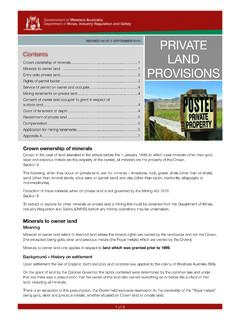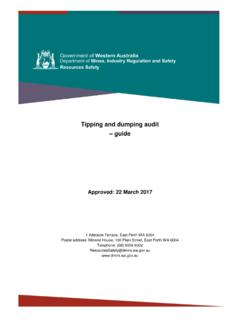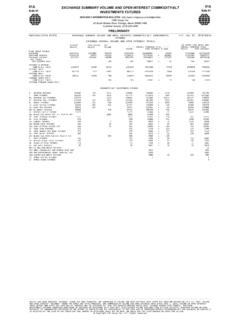Transcription of 2007 Mineral and Petroleum Statistics Digest
1 WESTERN AUSTRALIANM ineral and PetroleumSTATISTICS DIGEST2007 Cover pic courtesy of Woodside Karratha, Western AustraliaDisclaimerInformation provided in this Digest is made available without charge, as a public service, in good faith. The information provided is derived from sources believed to be reliable and accurate at the time of publication. However, use of the information in the Digest is at your own risk. The Digest is provided solely on the basis that users will be responsible for making their own assessment of the information provided therein and users are advised to verify all representations, statements and information for decisions that concern the conduct of business that involves monetary or operational user waives and releases the Department of Industry and Resources and the State of Western Australia and its servants to the full extent permitted by law from all and any claims relating to the use of the material in the Digest .
2 In no event shall the Department of Industry and Resources or the State of Western Australia be liable for any incidental or consequential damages arising from any use or reliance on any material in the 2008 Copyright in this document is reserved to the State of Western Australia. Reproduction except in accordance with copyright law is australian Mineral AND Petroleum Statistics Digest 2007 LIST OF FIGURES, TABLES And mApSFIGURESF igure 1 mining Investment3 Figure 2 Average price Comparison 2006 and 20073 Figure 3 Western australian merchandise Exports 20073 Figure 4 Selected WA Commodities Relative to World production Ending 2007, by Quantity5 Figure 5 Sales by Commodity 20075 Figure 6 Value of Mineral and Petroleum by Commodity6 Figure 7major Commodities by Value 2006 and 20076 Figure 8 non-Rural Commodity price Index6 Figure 9 Exchange Rate US$/A$7 Figure 10 Exchange Rate Trade Weighted Index7 Figure 11 australian dollar Exchange Rate Against major Currencies7 Figure 12 Gold Exports8 Figure 13 Western australian Mineral and Petroleum Exports 20078 Figure 14 Western australian merchandise Exports 20078 Figure 15 Western australian merchandise Exports 20078 Figure 16petroleum Exports9 Figure 17 Crude Oil and Condensate Exports9 Figure 18 Iron Ore Exports9 Figure 19 Alumina Exports9 Figure 20nickel Exports9 Figure 21 Heavy Mineral
3 Sands Export9 Figure 22 Iron Ore price10 Figure 23 Gold price10 Figure 24 Tapis Crude Oil price10 Figure 25nickel price10 Figure 26 Alumina price10 Figure 27 LnG Import prices11 Figure 28 Average LnG Import prices11 Figure 29 Average natural Gas prices11 Figure 30 Historic Oil price12 Figure 31 Historic Gold price12 Figure 32 Historic nickel price12 Figure 33 Gold Quantity and Value by Quarter13 Figure 34nickel Quantity and Value by Quarter13 Figure 35 Heavy Mineral Sands Quantity and Value by Quarter13 Figure 36 Iron Ore Quantity and Value by Quarter13 Figure 37 Alumina Quantity and Value by Quarter13 Figure 38 Crude Oil and Condensate Quantity and Value by Quarter 13 Figure 39nickel Quantity14 Figure 40 Gold production14 Figure 41 Heavy Mineral Sands Value of production14 Figure 42 Crude Oil and Condensate Quantity15 Figure 43 Iron Ore Quantity15 Figure 44 Alumina Quantity15 Figure 45mineral Exploration Expenditure16 Figure 46petroleum Exploration Expenditure16 Figure 47 Crude Oil and Condensate production 200716 Figure 48natural Gas production16 Figure 49 Regional Value of minerals and Petroleum 200720 Figure 50 Royalty Receipts 200722 Figure 51 Royalty Receipts by Commodity22 TABLEST able 1 Quantity and Value of minerals and petroleum17 Table 2 Quantity and Value of Selected major Commodities18 Table 3 Value of minerals and Petroleum by Region by Commodity 200720 Table 4 Value of minerals and Petroleum
4 By Region by Local Government Authority 200721 Table 5 Royalty Receipts 2006 and 200722 Table 6principal Mineral and Petroleum producers 23 MAPSmap 1 Local Government Boundaries27map 2 Local Government Boundaries 28map 3major Mineral and Petroleum projects in Western Australia29 WESTERN australian Mineral AND Petroleum Statistics Digest 20072 WESTERN australian RESOURCES INDUSTRY CONTINUES TO GROWIn 2007 the estimated value of Western Australia s Mineral and Petroleum industry reached $ billion. This represented a seven per cent ($ billion) increase compared to the previous year. This result was achieved through strong overseas demand for Mineral and Petroleum commodities, increased output and strong commodity prices.
5 When analysing this outcome it needs to be considered in the context of an 11 per cent strengthening of the australian dollar against the US dollar, adverse weather conditions in the first quarter of 2007 plus ongoing difficulties with equipment supplies and skills for most of the increase in value was nickel, iron ore and Petroleum . These three sectors accounted for around 75 per cent of the total value of $ billion for 2007. Petroleum accounted for the highest portion of sales with 31 per cent of the total value while iron ore represented 30 per cent and nickel accounted for 13 per commodities actually recorded decreased levels of physical output, notably lead, coal, cobalt, gold and nickel. However, very strong commodity prices translated to the value of both cobalt and nickel rising despite these production is the largest resource sector by value and an increase in sales of $ billion saw it reach a record level of $ billion.
6 This eight per cent rise in value was chiefly due to continued high world oil prices and a ten per cent increase in crude oil sales total of 264 million tonnes of iron ore was sold in 2007, valued at $ billion, an increase of five per cent and nine per cent respectively. Iron ore is competing with Petroleum to be the largest resource sector by value with the commodity accounting for 30 per cent of total minerals and Petroleum sales in Western Australia in 2007. With mine and port expansions, proposed new developments and anticipated continued strong demand, it is expected that this sector will continue its record breaking run well beyond is the third largest commodity by value, earning approximately $7 billion in 2007.
7 This was an astonishing 19 per cent ($ billion) increase compared to the previous year. Sales quantities actually dropped eight per cent from 2006 to 160,457 tonnes, however, strong world prices for nickel ensured that overall value in order of value to the State is alumina. It had a sales value of $ billion in 2007, down marginally from the previous year by just over one per cent. Alumina is followed closely by gold with a sales value of $ billion, a decline of four per 2007 the price of lead almost doubled. Coupled with an increase in the output of copper and zinc, the Western australian base metals sector performed strongly, increasing in value by ten per cent to $ base metals sector performed strongly with increased output for both zinc and copper.
8 Strong prices resulted in a ten per cent increase in the value of base metals in 2007 to reach a total of $ billion. Diamond sales also increased, recording a 38 per cent rise in quantity sold to reach million carats and salt sales of $306 million were also up by 27 per cent from average per cent appreciation in the australian dollar against the US dollar in 2007 had a significant influence on the overall Mineral and Petroleum result. Rising commodity prices were to a large extent offset by the appreciation of the australian dollar. This resulted in changes in the value of commodities not being as substantial as predicted. The table below reflects the price changes in 2007 compared to 2006, in both US dollar and australian dollar $ TermsA$ TermsLeadUp 99%Up 78%CobaltUp 73%Up 56%NickelUp 53%Up 39%GoldUp 15%Up 4%Iron OreUp 12%SteadyCrude OilUp 11%Down 1%AluminaUp 7 %Down 3%CopperUp 6%Down 5%ZincDown 1%Down 11%It is expected the strong demand for Western Australia s commodities by the State s trading partners will continue beyond 2008 due to the prominence of China as a major export destination and its continuing economic australian Mineral AND Petroleum Statistics Digest 2007 Some additional indicators of Western Australia s significance in the national resource industry are that the State accounts for.
9 Approximately 50 per cent of Australia s total value of Mineral and Petroleum sales (based on DoIR and ABARE published data, ABARE australian Commodities December Quarter 2007, page 592); and 71 per cent of Australia s oil and condensate production (based on published data by ABARE, australian Mineral Statistics quarterly 2007 publications).The importance of the State s mining developments is reflected in the latest australian Bureau of Statistics (ABS) investment figures for 2007. This data shows that Western Australia s share of national mining capital expenditure rose from 61 per cent ($ billion) in 2006 to 62 per cent ($ billion) in 2007, a 19 per cent increase for the previous year. National mining capital expenditure only rose 16 per cent from the previous year, indicating 70 per cent of this increase was invested in Western Australia topped all other States contributing a little under 37 per cent ($ billion) towards the total australian merchandise exports for 2007, an increase of 12 per cent on the previous year.
10 Queensland followed with 20 per cent, then New South Wales with 17 per cent and Victoria contributing about 12 per Western australian mining and Petroleum sectors contributed a massive 86 per cent ($ billion) toward the State s merchandise exports in 2007 which highlights the importance of these sectors on both the Western australian and national economies. Figure 1 Mining Investment Source: ABS $ million050001000015000200002500030000200 7200620052004200320022001200019991998 Rest of AustraliaWestern AustraliaFigure 3 Western australian Merchandise Exports 2007 $ billion Source: DoIR and ABS Minerals & Petroleum 86%Other* 14%14%86%* Other includes wheat, wool, live animals, seafood, meat, pearls and other agricultural and manufactured 2 Average Price Comparison 2006 and 2007 Source.












